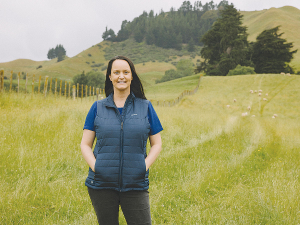Strong growth in farm salaries - report
A new report shows farm employers across the dairy, sheep and beef, and arable sectors have continued to invest strongly in one of their greatest assets – their staff.
 Rabobank’s Emma Higgins says slowing global milk production will eventually match the tepid demand and prevent further significant price declines.
Rabobank’s Emma Higgins says slowing global milk production will eventually match the tepid demand and prevent further significant price declines.
A full rebalance of China’s dairy market is not expected in the near future, so dairy farmers in New Zealand and around the world will need to manage through more financial pain in the months ahead.
That’s the view in the latest Rabobank Q3 Global Dairy Quarterly report.
However, it says with lower global prices stemming supply growth in key dairy production regions, there is an increasing possibility of a demand resurgence emerging well before milk output can recover – creating a ‘whiplash effect’ in global markets and a bullish run in to 2024.
Co-author and Rabobank senior agricultural analyst Emma Higgins says the severity of the economic headwinds and the duration of the lull in economic growth in China remain uncertain, reducing the likelihood of a strong demand recovery.
A myriad of factors have converged to drive the longed-for dairy demand recovery in China – the world’s largest dairy importer – even further into the future. Lower demand for dairy imports in China has reduced global dairy prices and production.
“Driven by reductions in most key global regions, milk production from the Big 7 export regions is now anticipated to grow by 0.3% year-on-year in 2023, downgraded from last quarter’s estimate of 0.7%. Into 2024 output is expected to climb by 0.4%, far less than the 1.6% annual average gain from 2010-2020,” Higgins explains.
She says slowing global milk production will eventually match the tepid demand growth noted in most regions, preventing further significant price declines.
While the immediate outlook remains challenging, Higgins says there is a ray of optimism for the months ahead as the US Class III milk price and the GDT-weighted average price both fell to Covidlevel lows in recent weeks, allowing buyers to replenish stocks at bargain prices.
Although the Global Dairy Trade (GDT) index has weakened, demand from China still accounts for roughly 30-40% of sales since Q2 and demand from Mexico - the second largest dairy importer - has also been robust.
These factors make a demand-led resurgence in global dairy markets in the months ahead a growing possibility.
Higgins says if buyers feel confident prices have hit a low this cycle and flock to buy products en masse, this could create a shortage of milk and increase demand, creating a whiplash like effect for global dairy prices.
While this may provide some reason for optimism over the coming months, dairy farmers will need to manage through the current financial pain first. Weaker Chinese import demand has seen Rabobank revise its milk price forecast for this season down to NZ$6.75/ kgMS, in line with Fonterra.
Higgins says there are several watch factors for the coming months, which hold both ‘upside’ and ‘downside’ risks for global milk prices.
“Chinese import demand remains the most influential of these, so any signals of increased Chinese buying will be monitored closely, especially due to weaker forecasted milk production growth in dairy export regions.”
Another 16 commercial beef farmers have been selected to take part in the Informing New Zealand Beef (INZB) programme designed to help drive the uptake of genetics in the industry.
Trade Minister Todd McClay says Kiwi exporters will be $100 million better off today as the NZ-EU Free Trade Agreement (FTA) comes into force.
Making things simpler, not harder, for deer farmers in farm planning and coping with regulations is Deer Industry New Zealand (DINZ) industry capability manager John Ladley’s current focus.
Rural Women New Zealand (RWNZ) is launching an online business directory called The Country Women’s Collective to promote and support entrepreneurial rural women.
New Zealand actor Sam Neill has joined the Campaign for Wool NZ as an ambassador, lending his name and profile to educate and advocate for New Zealand strong wool.
Living labs that bring together expertise at locations around New Zealand are among potential solutions identified by researchers to help the country move towards a more climate resilient future.

OPINION: The new government has clearly signalled big cuts across the public service.
OPINION: Your canine crusader is not surprised by the recent news that New Zealand plant-based ‘fake meat’ business is in…